Japan eyes 80% cut in 298,000 death toll for potential Nankai monster quake
Measures include fortifying homes and fire safety installations, as well as building more embankments and emergency shelters

Japan is seeking to reduce by 80 per cent in the next decade its estimated 298,000 death toll from a potential megaquake in the Nankai Trough.
Authorities also intend to halve the maximum number of buildings expected to be completely destroyed in such a disaster from the current projection of 2.35 million.
The targets align with a 2104 basic blueprint but will also take into account the latest damage estimates released in March, according to the Kyodo news agency. A revised plan for emergency earthquake response and disaster mitigation for the next 10 years is in the works.
The draft was approved at a ruling Liberal Democratic Party panel meeting on Tuesday and is expected to be adopted by the government’s Central Disaster Management Council in early July.
The earthquake task force’s revised estimate showed only a 20 per cent reduction in 2014’s projected death toll of 332,000 and 2.5 million destroyed buildings, The Japan Times newspaper reported.
To hit the latest mark, the government plans to fortify homes by reinforcing older structures and encouraging homeowners to install quake-sensitive circuit breakers to prevent fires, according to The Economic Times newspaper. Japan will also build more embankments and upgrade infrastructure to withstand tsunamis and floods.
Other measures include developing evacuation shelters and stockpiling emergency supplies to prevent earthquake-related deaths.
Apart from structural reinforcement, public awareness and community-based planning was key to reducing the death toll and damage projections, officials said. All local governments in designated tsunami-risk areas will be required to release hazard maps and conduct evacuation drills within about five years.

The Nankai Trough, an 800km (500-mile) undersea trench running from Shizuoka, west of Tokyo, to the southern tip of Kyushu Island, sits where two tectonic plates meet.
As they move, the plates become stuck, storing up vast amounts of energy that is released when they break free, causing potentially massive earthquakes or megaquakes.
A quake of magnitude 7 or above could cause a tsunami of between 3 metres (10 feet) and 34 metres in some parts of the country, according to the latest projections.
In January, a government panel said the probability of such a megaquake in the next 30 years had marginally increased, with a 75 per cent to 82 per cent chance of it happening.